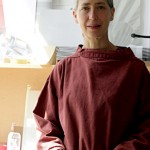
Shelley James
RCA
shelley.james@network.rca.ac.uk
www.shelleyjames.co.uk
Illustrated Talk
Crossing the line: mechanical reproduction and illusions of space
The Konkrete Kunst manifesto, formulated by Theo von Doesbourg and published in 1930, called for a new and democratic attitude to the arts, a pure abstraction seeking to express elemental truths, free from representation and symbolism.
In this paradigm, the work should be fully conceived and planned in the mind of the artist before execution without reference to natural forms, narrative or sentimentality. Clarity should be the prime concern, accepting, indeed emphasising the reality of plane, line and tone as simple material facts, bearing no meaning beyond their physical existence. The manifesto also specifies that the means of production should be mechanical, eliminating all gestures and marks that may refer to a process, time or place beyond the visible actuality of the work.
Photomechanical techniques, offering a precise and repeatable transfer from mind to material and with the potential to eliminate traces of the maker’s hand, were central to this group of artists from philosophical and technical perspectives.
Paradoxically, many of those considered representative of this movement such as Bridget Riley and Ludwig Wilding, exploited these qualities to expose the entirely referential and subjective process of visual perception, using simple graphic motifs to generate compelling optical illusions. Wilding in particular worked with psychologists for over 40 years, printing finely calibrated lines on paper and on transparent overlays to create interference patterns that give rise to extraordinary spatial and temporal effects that could be predicted and measured, pioneering the application of psychophysical techniques to arts practice.
My paper will review Ludwig Wilding’s use of printmaking processes in the context of the Concrete Art movement and his ground breaking collaboration with scientists. I will then describe my own research combining print on glass and paper to explore the boundaries between material and virtual space.
